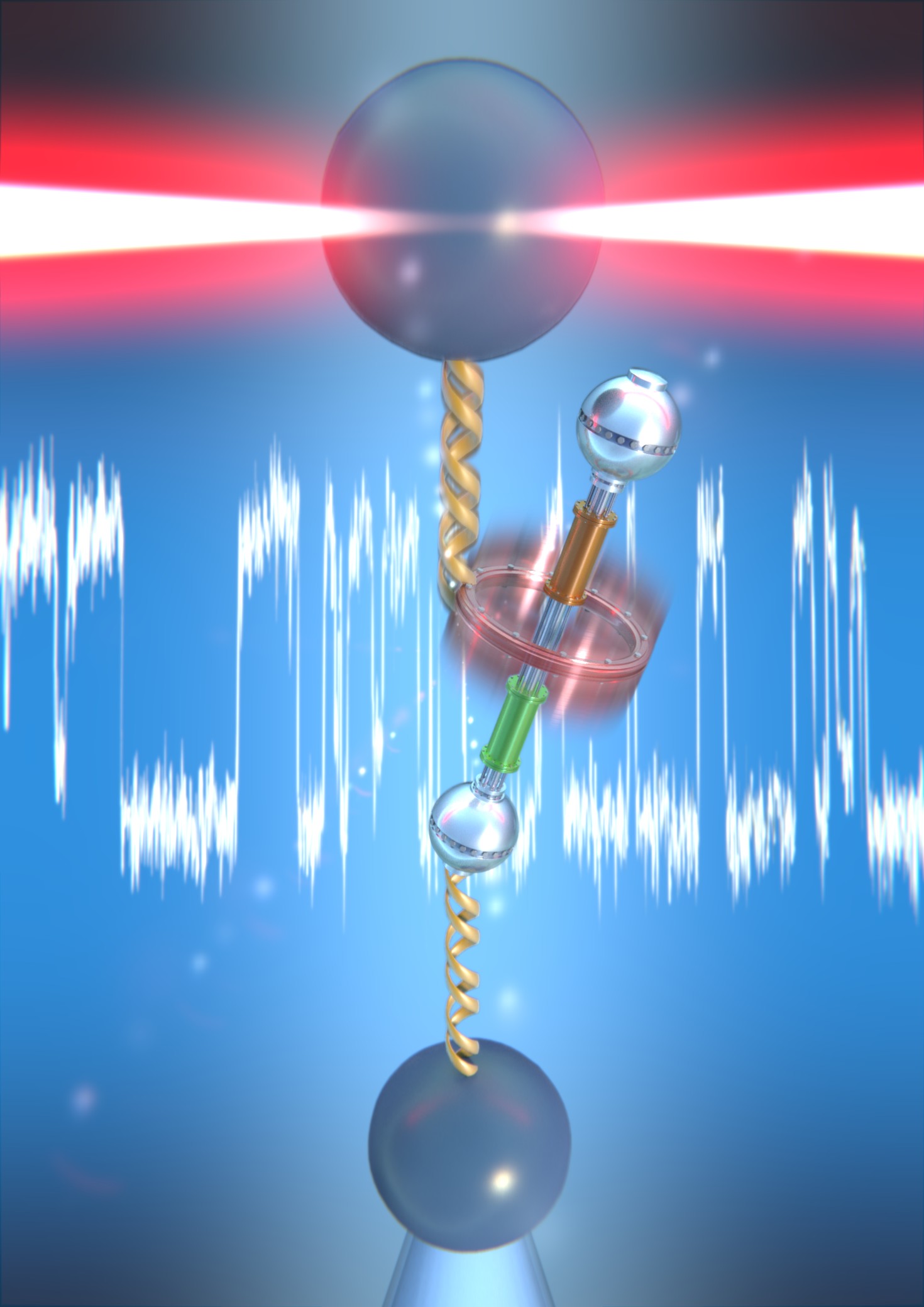Five minutes in the life of a molecular shuttle
31.10.2018
 |
|
The molecular shuttle is attached to two polystyrene beads through two DNA molecules. Picture credit: Scixel. |
Scientists from IMDEA Nanociencia follow and operate one molecular shuttle-at-a-time, in real time, for several hundreds of cycles.
In a molecular shuttle, a ring molecule is trapped onto a linear thread and can move between two portions of the thread, called stations. Although the thermodynamics of synthetic molecular shuttles are to date well understood, information on single-molecule mechanics is lacking.
Scientists from IMDEA Nanociencia and the University of Barcelona -led by Emilio Pérez and Borja Ibarra- have engineered a novel system to measure the dynamics of a single artificial molecular switch under near-physiological conditions. The system comprises a tetraamide macrocycle locked onto a oligoethyleneglycol thread by two diphenylethyl groups (stoppers) at the end of the axle, and fumaramide and succinic amide-ester stations. Each station can stablish up to four hydrogen bonds with the macrocycle. This single shuttle was interfaced with two functionalized beads using DNA molecules. The beads are trapped with optical tweezers and serve as probes to control the stochastic motion of the macrocycle between two stations. The exquisite sensitivity of optical tweezers and the robustness of their method allowed the authors to quantify the piconewton forces (<10 pN) and nanometric displacements (15 nm) defining the mechanical operation of the switch and to control its operation during minutes. Pulling the pipette away from the optical trap shifted the binding equilibrium of the ring between the two stations, whereas holding the force constant close to the value under which the ring has an equal probability of residing in either of the two stations (coexistence force), enabled the authors to follow the real-time kinetics of shuttling
This is the first time that the Brownian movement of the macrocycle of a molecular shuttle between the two stations has been measured in real time. Overall, the results revealed the mechanical strength at each station, the real-time kinetics of shuttling and their response to mechanical force, and a detailed free-energy landscape of the shuttle-DNA construct.
The rich information provided by this experiment “cannot be obtained from the bulk, and provides an insight into the inner workings of a synthetic molecular shuttle under near-physiological conditions, in water and with a pH 7.5” Emilio Pérez says. For example, the energy profiles reveal the distance to the real transition state (that is smoother as previously thought); the asymmetry of the curve below and above of the coexistence force, and the population of each state based on the measurement of the real-time extension.
The study combines the discoveries by Nobel prizes in Chemistry 2016 and Physics 2018, bringing together the molecular machinery and the optical tweezers in the same experiment. Borja Ibarra says: “We hope that this technique will be applied to study the operational dynamics of other synthetic molecular devices, to compare directly the operation of artificial and biological motors”. This advance is of relevance to nanotechnology and to biology, where many biochemical functions are based on molecular shuttles. The academic interest for synthetic molecular shuttles resides in their potential applications in molecular electronics, nanomedicine and as crucial components of complex molecular machinery.
Emilio M. Perez and Borja Ibarra are researchers at IMDEA Nanociencia. The work is the result of an interdisciplinary team effort between IMDEA Nanociencia and University of Barcelona: supramolecular chemistry, biochemistry, molecular biophysics and statistical physics. The research has been funded partially by the “Severo Ochoa” programme for Centres of Excellence in R&D.
Teresa Naranjo, Kateryna M. Lemishko, Sara de Lorenzo, Álvaro Somoza, Felix Ritort, Emilio M. Pérez and Borja Ibarra, “Dynamics of individual molecular shuttles under mechanical force” Nature Communications 2018.
Full paper: https://www.nature.com/articles/s41467-018-06905-8
|
Contact: Prof. Emilio Pérez
emilio.perez [at] imdea.org
Twitter: @emilioperezlab
IMDEA Nanociencia Outreach Office
divulgacion.nanociencia [at] imdea.org
+34 91 299 87 12
Twitter: @IMDEA_nano,
Facebook: @IMDEANanociencia
|




